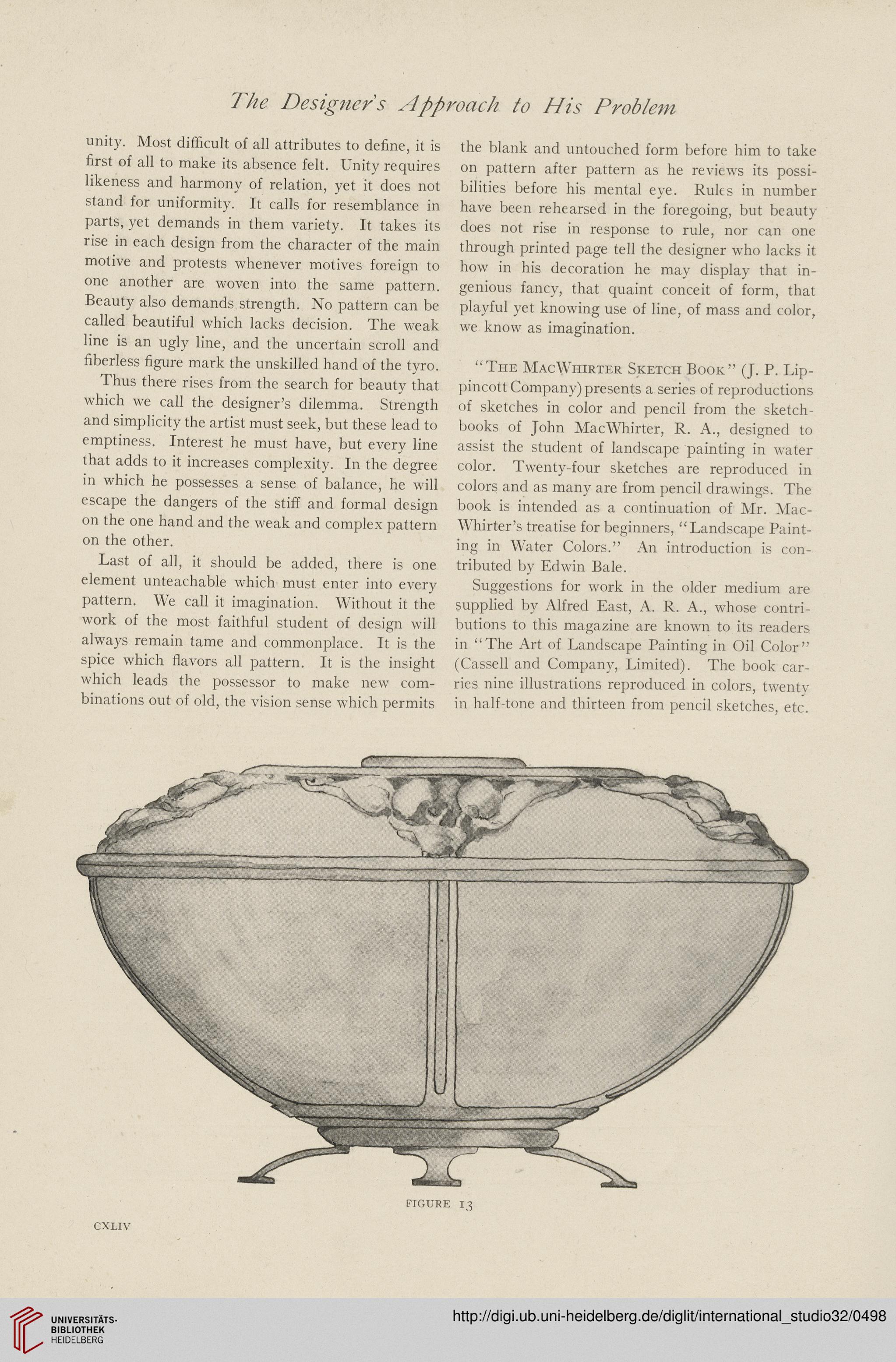The Designers Approach to His Problem
unity. Most difficult of all attributes to define, it is
first of all to make its absence felt. Unity requires
likeness and harmony of relation, yet it does not
stand for uniformity. It calls for resemblance in
parts, yet demands in them variety. It takes its
rise in each design from the character of the main
motive and protests whenever motives foreign to
one another are woven into the same pattern.
Beauty also demands strength. No pattern can be
called beautiful which lacks decision. The weak
line is an ugly line, and the uncertain scroll and
fiberless figure mark the unskilled hand of the tyro.
Thus there rises from the search for beauty that
which we call the designer’s dilemma. Strength
and simplicity the artist must seek, but these lead to
emptiness. Interest he must have, but every line
that adds to it increases complexity. In the degree
in which he possesses a sense of balance, he will
escape the dangers of the stiff and formal design
on the one hand and the weak and complex pattern
on the other.
Last of all, it should be added, there is one
element unteachable which must enter into every
pattern. We call it imagination. Without it the
work of the most faithful student of design will
always remain tame and commonplace. It is the
spice which flavors all pattern. It is the insight
which leads the possessor to make new com-
binations out of old, the vision sense which permits
the blank and untouched form before him to take
on pattern after pattern as he reviews its possi-
bilities before his mental eye. Rules in number
have been rehearsed in the foregoing, but beauty
does not rise in response to rule, nor can one
through printed page tell the designer who lacks it
how in his decoration he may display that in-
genious fancy, that quaint conceit of form, that
playful yet knowing use of line, of mass and color,
we know as imagination.
“The MacWhirter Sketch Book” (J. P. Lip-
pincott Company) presents a series of reproductions
of sketches in color and pencil from the sketch-
books of John MacWhirter, R. A., designed to
assist the student of landscape painting in water
color. Twenty-four sketches are reproduced in
colors and as many are from pencil drawings. The
book is intended as a continuation of Mr. Mac-
Whirter’s treatise for beginners, “Landscape Paint-
ing in Water Colors.” An introduction is con-
tributed by Edwin Bale.
Suggestions for work in the older medium are
supplied by Alfred East, A. R. A., whose contri-
butions to this magazine are known to its readers
in “The Art of Landscape Painting in Oil Color”
(Cassell and Company, Limited). The book car-
ries nine illustrations reproduced in colors, twenty
in half-tone and thirteen from pencil sketches, etc.
figure 13
CXLIV
unity. Most difficult of all attributes to define, it is
first of all to make its absence felt. Unity requires
likeness and harmony of relation, yet it does not
stand for uniformity. It calls for resemblance in
parts, yet demands in them variety. It takes its
rise in each design from the character of the main
motive and protests whenever motives foreign to
one another are woven into the same pattern.
Beauty also demands strength. No pattern can be
called beautiful which lacks decision. The weak
line is an ugly line, and the uncertain scroll and
fiberless figure mark the unskilled hand of the tyro.
Thus there rises from the search for beauty that
which we call the designer’s dilemma. Strength
and simplicity the artist must seek, but these lead to
emptiness. Interest he must have, but every line
that adds to it increases complexity. In the degree
in which he possesses a sense of balance, he will
escape the dangers of the stiff and formal design
on the one hand and the weak and complex pattern
on the other.
Last of all, it should be added, there is one
element unteachable which must enter into every
pattern. We call it imagination. Without it the
work of the most faithful student of design will
always remain tame and commonplace. It is the
spice which flavors all pattern. It is the insight
which leads the possessor to make new com-
binations out of old, the vision sense which permits
the blank and untouched form before him to take
on pattern after pattern as he reviews its possi-
bilities before his mental eye. Rules in number
have been rehearsed in the foregoing, but beauty
does not rise in response to rule, nor can one
through printed page tell the designer who lacks it
how in his decoration he may display that in-
genious fancy, that quaint conceit of form, that
playful yet knowing use of line, of mass and color,
we know as imagination.
“The MacWhirter Sketch Book” (J. P. Lip-
pincott Company) presents a series of reproductions
of sketches in color and pencil from the sketch-
books of John MacWhirter, R. A., designed to
assist the student of landscape painting in water
color. Twenty-four sketches are reproduced in
colors and as many are from pencil drawings. The
book is intended as a continuation of Mr. Mac-
Whirter’s treatise for beginners, “Landscape Paint-
ing in Water Colors.” An introduction is con-
tributed by Edwin Bale.
Suggestions for work in the older medium are
supplied by Alfred East, A. R. A., whose contri-
butions to this magazine are known to its readers
in “The Art of Landscape Painting in Oil Color”
(Cassell and Company, Limited). The book car-
ries nine illustrations reproduced in colors, twenty
in half-tone and thirteen from pencil sketches, etc.
figure 13
CXLIV





